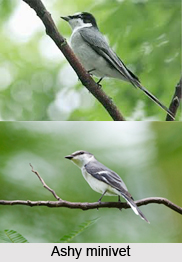 Ashy Minivet is an Indian Bird. that bears a scientific name "Pericrocotus divaricatus". It is an Indian bird that forages in canopy.
Ashy Minivet is an Indian Bird. that bears a scientific name "Pericrocotus divaricatus". It is an Indian bird that forages in canopy.
Ashy minivet is a passerine bird of eastern Asia belonging to the minivet genus Pericrocotus in the cuckooshrike family Campephagidae. While most of the minivets have shades of yellow, orange and red in their plumage, this species has only greys, whites and blacks.
Difference between Male and Female of Ashy Minivet
The male Ashy Minivet is distinctive with a white face and black nape although females can be confused with the female of the Brown-Rumped Minivet.
Forage of Ashy Minivet
Ashy Minivet forages in the canopy, often along with other minivets and join mixed-species foraging flocks.
Size of Ashy Minivet
Ashy Minivet is 18.5-20 cm long. The male is grey above and whitish below. It has a black cap with a white forehead and there is a white band across the flight-feathers. The outer tail feathers are white.
Bill and Feet of Ashy Minivet
The bill and feet of Ashy Minivet are black. The female`s cap is grey apart from a black band between the bill and eye and a narrow white band above it.
Sound of Ashy Minivet
The call of Ashy Minivet is a high-pitched, metallic trill. It is considered as closely related to Pericrocotus roseus and Pericrocotus cantonensis but differs in moult pattern. It is one of the few passerine birds that moult their primaries twice in a year and is the longest distance migrant among the minivets.
Breeding of Ashy Minivet
Ashy Minivet breeds in south-east Siberia, north-east China, Korea and Japan. Birds in the Ryukyu Islands of southern Japan are commonly considered to be a separate species-Ryukyu minivet (P. tegimae).
Migration of Ashy Minivet
Ashy Minivet is a long distance migrant, wintering in South and South-east Asia as far south as Sumatra, Borneo and the Philippines.
Habitat of Ashy Minivet
Ashy Minivet is found in forest as well as in more open areas with scattered trees. It forages in the tree canopy for insects sometimes joining mixed-species foraging flocks. Migrant birds can often be seen in large flocks.
Status of Ashy Minivet
The status of Ashy Minivet is considered to be secure and is considered as a "least concern" species by the IUCN. Populations of the species on the Amami Island was found to have increased from 1985-2001.



















